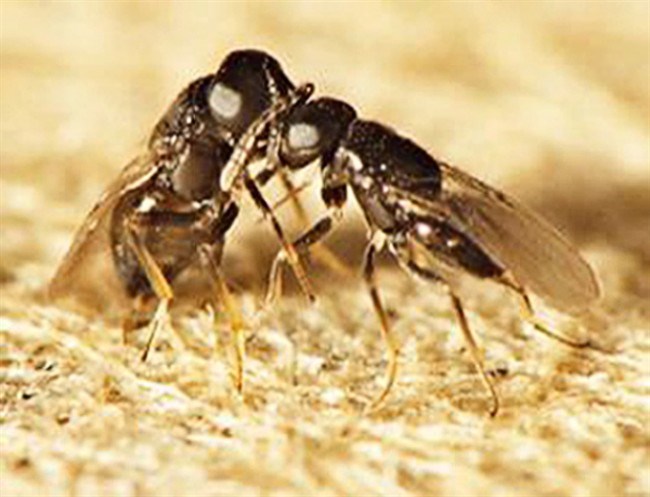VANCOUVER - Biologists have discovered that a species of fast-flying male wasp uses some smooth moves to build harems of female lovers.
A team of biologists from Simon Fraser University used high-speed cameras to record and observe the mating rituals of the tiny parasitic wasps, Ooencyrtus kuvanae.
Lead researcher Kelly Ablard says the female wasps emerge from their eggs sexually mature and looking for love. Lusty little buzzers are at the ready.
Female wasps mate just once in their four- to six-week lifetimes, Ablard says, and so it is that the wasps' mating ritual bares a striking resemblance to a nightclub at midnight.
"Females of this species only mate once and they mate when they emerge... and the males at this point only really have one opportunity to get a female and mate with her," says Ablard, whose research appears in the latest edition of the journal Behavioural Processes.
Males emerge from the egg about a day before females, and wait.
In this highly competitive situation, some crafty insect Casanovas have devised an antennae-to-antennae love tap that marks females with a potent pheromone.
"Certain males in a competitive setting will adopt a type of mating strategy, a mating tactic, that allows them to basically collect, gather and guard a harem of females, which is highly unusual for insects, or invertebrates for that matter," Ablard says.
The chemical substance serves the double purpose of marking the females so the male can find them later for a few romantic seconds, and deterring other, slower, lovesick suitors.
"That female will wait for him to come back and mate her later. In the meantime, he runs around and he tags a whole bunch of other females for this harem," Ablard says.
This species of parasitic wasp grows to about two millimetres in length, and lays eggs inside the eggs of the gypsy moth. Not natural to North America, they were brought here from Japan in the early 20th century as a biological control agent for the moths, an invasive species harmful to hardwood trees.
Ablard, who has studied the wasps since 2006 and oversaw this particular study for about three years, says females live four to six weeks in captivity and males three to four weeks.
Some males do mate 'em as they meet 'em, Ablard says, but the quicker, more agile males mate with multiple females.
The faster wasps are likely in better condition physically, and so they are perceived by females as higher quality, she says.



